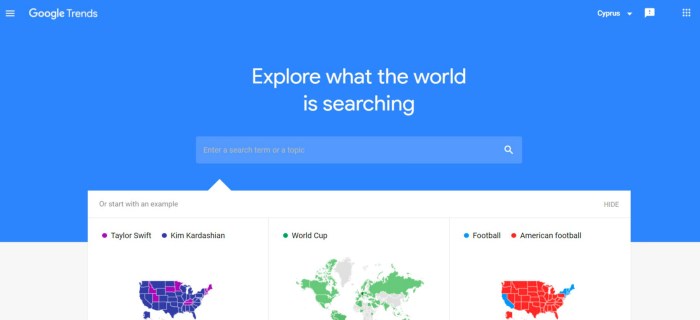Using Google Trends for Content Ideas sets the stage for a dynamic journey into the realm of content creation, offering a plethora of insights to fuel your creativity and captivate your audience.
From uncovering popular search queries to leveraging seasonal trends, this guide will equip you with the tools needed to stay ahead in the competitive world of online content.
Introduction to Google Trends
Google Trends is a powerful tool that allows users to explore the popularity of search queries on Google. It provides valuable insights into what people are searching for online, helping content creators stay ahead of the curve and create relevant and engaging content.
Benefits of Using Google Trends
- Identifying trending topics: Google Trends enables content creators to identify popular topics in real-time, allowing them to create content that resonates with their audience.
- Understanding audience interests: By analyzing search trends, creators can gain a better understanding of what their target audience is interested in, helping them tailor their content to meet their audience’s needs.
- Seasonal content planning: Google Trends can also help creators anticipate seasonal trends and plan their content calendar accordingly to capitalize on peak interest periods.
Popular Search Queries

Finding popular search queries on Google Trends is a great way to stay updated on what people are searching for online. By exploring trending topics, you can gain valuable insights into current interests and preferences. Additionally, filtering search queries based on location, time, and category allows you to tailor your content to specific audiences and trends.
Identifying Popular Search Queries
- Visit the Google Trends website and enter a or topic in the search bar.
- Explore the related queries and topics section to discover popular search terms related to your initial search.
- Pay attention to the search interest over time graph to see how the popularity of a specific query has evolved.
Exploring Trending Topics
- Check the “Trending searches” section on Google Trends to see what topics are currently trending in real-time.
- Use the “Explore” feature to delve deeper into specific topics and see related queries, topics, and subregions.
- Compare multiple search terms to identify which one is more popular and relevant to your content strategy.
Filtering Search Queries, Using Google Trends for Content Ideas
- Utilize the location filter to see search trends in a specific country, city, or region.
- Adjust the time range to analyze search trends over a specific period, such as the past hour, day, week, month, or year.
- Choose a category filter to focus on search queries related to a specific topic, such as entertainment, sports, technology, or health.
Seasonal Trends: Using Google Trends For Content Ideas
Seasonal trends on Google Trends refer to patterns in search interest that occur at specific times of the year, such as holidays, seasons, or events. Understanding these trends can help content creators tailor their material to align with what people are searching for during that time.
Tailoring Content Based on Seasonal Trends
- Create holiday-themed content: For example, during Christmas, you can create gift guides, decorating tips, or recipes that are popular during the holiday season.
- Align with seasonal activities: For summer, you can focus on topics like outdoor activities, travel destinations, or summer fashion trends.
- Promote seasonal sales and promotions: Take advantage of peak shopping seasons like Black Friday, Cyber Monday, or back-to-school season to create content around discounts, deals, and promotions.
Leveraging Seasonal Trends for Content Creation
- Plan ahead: Research upcoming seasonal trends and plan your content calendar accordingly to ensure you are prepared for peak search interest.
- Use Google Trends: Monitor trending topics and search queries related to upcoming seasons to identify popular s and topics to incorporate into your content.
- Create evergreen content: While seasonal content is important, make sure to balance it with evergreen content that remains relevant year-round to maintain a consistent flow of traffic to your site.
Regional Insights
When it comes to creating content that resonates with your target audience, regional insights can play a crucial role in crafting a successful strategy. Google Trends offers valuable data on search trends at a regional level, allowing you to understand the specific interests and preferences of users in different locations.
Exploring regional data on Google Trends can help you identify unique trends and topics that are popular in specific areas. By analyzing regional insights, you can tailor your content to meet the needs and preferences of users in different regions, ultimately increasing engagement and driving traffic to your website.
Analyzing Regional Data
- Identify Key Regions: Start by selecting the regions you want to target based on your audience demographics or business goals.
- Compare Search Interest: Use Google Trends to compare search interest for specific s or topics across different regions to identify regional variations.
- Identify Localized Trends: Look for trends that are specific to certain regions and incorporate them into your content strategy to make it more relevant and engaging.
- Create Localized Content: Develop content that is tailored to the interests and preferences of users in different regions to increase relevance and drive engagement.
Content Planning
In the world of content creation, planning is key to success. By utilizing Google Trends, you can gather valuable insights to guide your content strategy. Let’s dive into a step-by-step guide on how to effectively use Google Trends for content planning.
Utilizing Google Trends for Content Planning
Google Trends is a powerful tool that can help you identify trending topics and search queries that are popular among users. Here’s how you can use Google Trends for content planning:
- Start by entering a broad topic or related to your niche in the Google Trends search bar.
- Explore the related queries and topics section to uncover specific s that are currently trending.
- Look at the interest over time graph to see if there are any seasonal trends or spikes in search interest related to your topic.
- Utilize the regional insights feature to identify geographical areas where your topic is most popular.
- Validate your content ideas by comparing multiple s or topics to see which ones are gaining traction over time.
Remember, the key to successful content planning is to create valuable and engaging content that resonates with your target audience.
Competitor Analysis

When it comes to competitor analysis, Google Trends can be a game-changer for content creators. By utilizing this tool, you can gain valuable insights into what your competitors are doing and how their content is performing in comparison to yours. This information can help you identify gaps in your own strategy and make necessary adjustments to stay ahead in the game.
Using Google Trends for Competitor Analysis
- Compare Search Interest: One of the key ways to benchmark your content against competitors is by comparing search interest on Google Trends. This can give you an idea of which topics are resonating with the audience and where you might be falling short.
- Identify Trending Topics: By monitoring your competitors’ performance on Google Trends, you can identify trending topics that are driving traffic and engagement. This can help you tailor your content strategy to capitalize on current trends and stay relevant in the industry.
- Track Seasonal Trends: Another valuable strategy is to track seasonal trends and see how your competitors are adjusting their content to align with these trends. This can give you insights into what works during specific times of the year and help you plan your content calendar accordingly.





